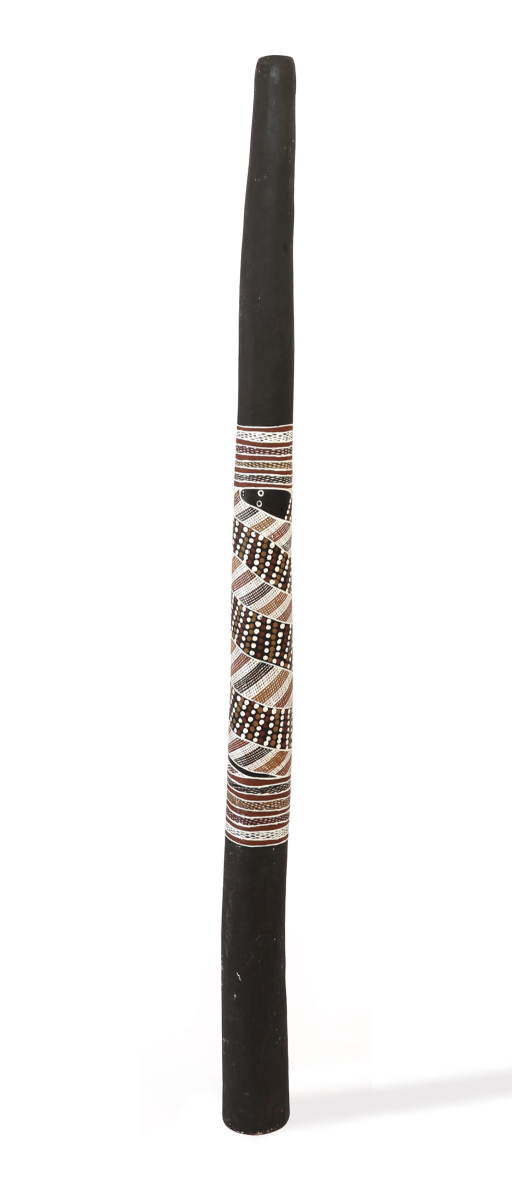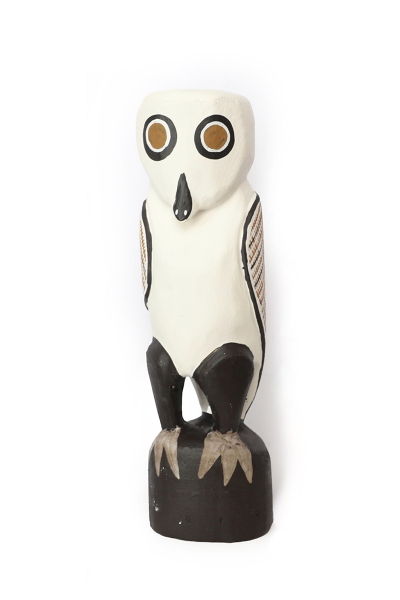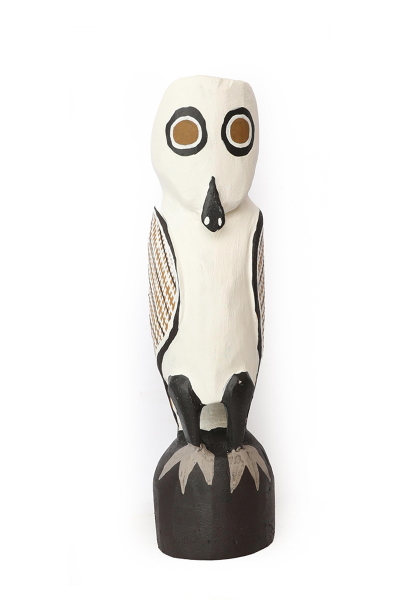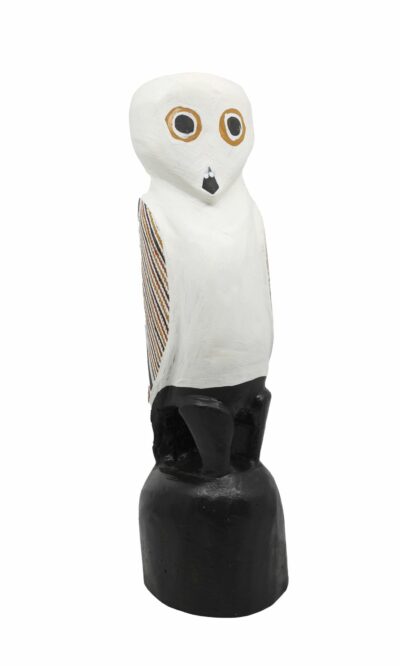Description
djuldjul gurruwiwi
Earth pigments on Stringybark hollow pole
126 x 9cm
Year: 2024
ID: 3885-24
Yiḏaki
Yiḏaki are didjeridus that are specific to North East Arnhem land in Australia’s Northern Territory, where the instrument originates. The term yiḏaki is used in Yolŋu (the nation of North East Arnhem land Aboriginal people) languages as the generic name for the didjeridu. The name yiḏaki is most correctly used for instruments from this region that have been solely made and decorated by Yolŋu people.
Yiḏaki were originally limited to the Northern extremes of Australia, in particular Arnhem land. In relatively recent years, yiḏaki spread to other parts of Australia and the rest of the world. Yiḏaki began to be manufactured in different ways and with different types of materials. It became commonly known as the didjeridu, a non-Aboriginal term for the instrument. Through it’s International popularisation as the didjeridu, it has been somewhat displaced from it’s spiritual and cultural roots that are still held by the Yolŋu in Arnhem land today. The Yolŋu are masters of making and playing the yiḏaki and are well known Internationally for their quality instruments and complex yiḏaki playing styles.
Yolŋu artists carefully select naturally occurring termite hollowed tree stems, which are cut and shaped into suitable sounding instruments. They are made with certain desired acoustics that can vary dramatically between different clans, from high pitch to very low. Typical yiḏaki have small natural wooden mouthpieces around 30mm in diameter and taper out to a diameter of around 100mm at the distal end. Having a small mouthpiece means they require less air to play and produce sound easily as a result.
The vast majority of yiḏaki are made from Gadayka (Stringybark – Eucalyptus Tetrodonta). Gadayka is by far the most common tree in the North East Arnhem land region and often grows in a conical shape, which is desired for acoustic reasons. Occasionally, Guŋurru ( Woolybutt – Eucalyptus Miniata) is used.
In appearance yiḏaki seem to be a simple instrument, however the playing styles of the Yolŋu are complex and require many years of practice. Yiḏaki are played by vibrating the lips which produces a basic tone. This tone is maintained continually using cyclic breathing and is varied through use of the playing pressure, the tension in the cheeks, the use of the diaphragm, the tongue position and the use of the voice.
Traditionally, yiḏaki are painted with naturally occurring red, white, black and yellow earth pigments. In recent years acrylic paints began to be used. Both the artwork and the sound and overall style of the yiḏaki denote cultural history and law.
This particular yiḏaki has been painted with earth pigments with designs that represents Garrimala, a billabong that is a sacred site for the Gälpu clan. Wititj is the all powerful rainbow serpent (olive python) that traveled through Gälpu clan lands and on further, during the days of early times called Waŋarr.
Djaykuŋ (depicted on this yiḏaki) is the Javanese file-snake and is a companion and possibly alternate incarnation of Wititj, living in among the dhatam (waterlillies), causing ripples and rainbows (djari) on the surface of the water.
The story of Wititj is of storm and monsoon, in the ancestral past. It has particular reference to the mating of Wititj during the beginning of the wet season when the djarrwa (square shaped thundercloud) begin forming and the lightning starts striking. They are decorated with dots, representing djari (rainbow) and the power of the lightning within them. The sun shining against the scales of the snake form a prism of light like a rainbow. The power of the lightning is made manifest when they strike their tongue, the thunder being the sound they make as they move along the ground.
The sacred clan design for Gälpu country has been used in the background. This miny’tji (line work) also refers to the power of the storm created by Wititj, the diagonal lines representing trees that have been knocked down as Wititj moves from place to place.
In mortuary ceremony for Gälpu, the slithering line of dancers take on the form of Wititj and coil in the sand searching for their place. As the spirit comes to rest it adopts the metaphor of a python settling its head into the fork in the tree, known as galmak, the final resting place of Wititj. Other references are the bunches of leaves dancers hold in their hands wet and shining in the sun, perhaps like a rainbow.





Reviews
There are no reviews yet.